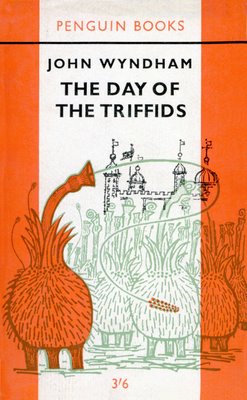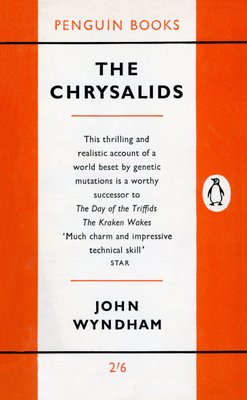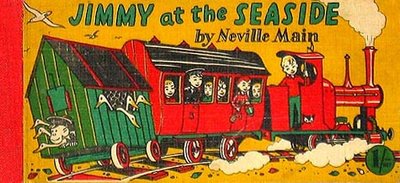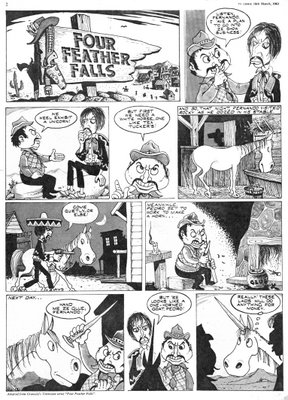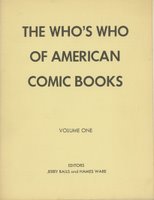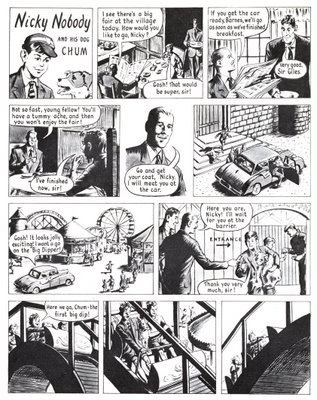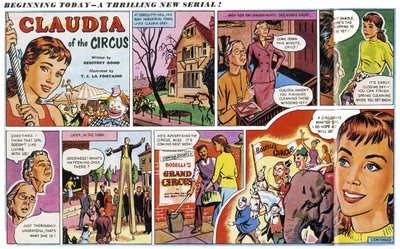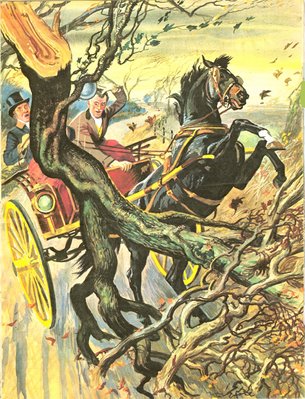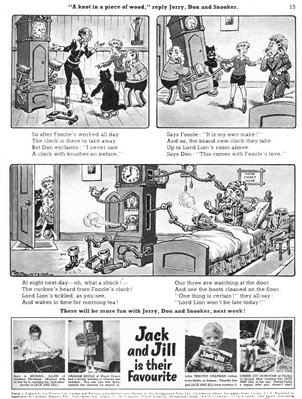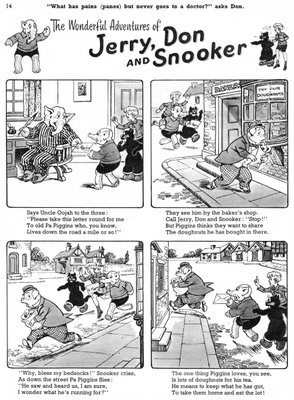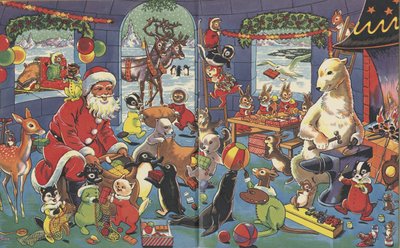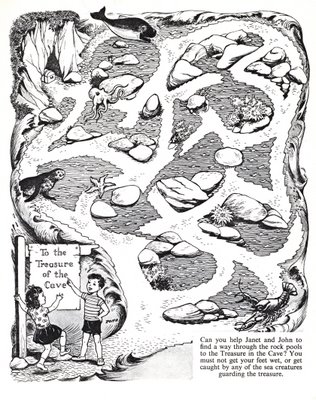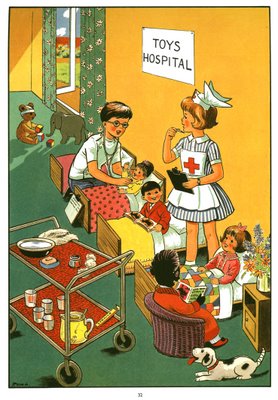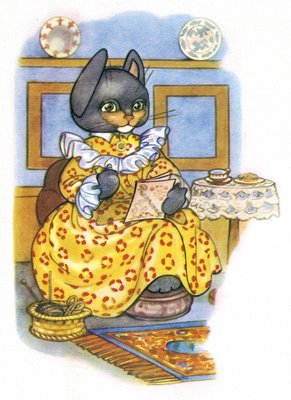
After all the sad news of the past couple of days I thought I'd knock out something fairly easy and, having already covered, poorly, Neville Main, I thought I'd take a look at Molly Blake, who also drew Muffin the Mule and was a fellow contributor to
TV Comic. I have a copy of the
TV Comic Annual 1958 (1957) to which she contributed the story 'Prudence Kitten's Pantomime'. What could be more innocuous? And from a previous glance around the internet, I knew there wasn't a huge amount of information.
Ah... how wrong I was. It didn't take very long to establish that Molly (rather than Mollie as she is credited in the annual) was the daughter of Annette Mills, famous as the actress and singer who starred alongside Muffin the Mule in
For The Children and
Children's Hour. Prudence Kitten (a glove puppet rather than a marionette) was created by Mills for very young children and made her debut on
For The Children on 7 June 1950.
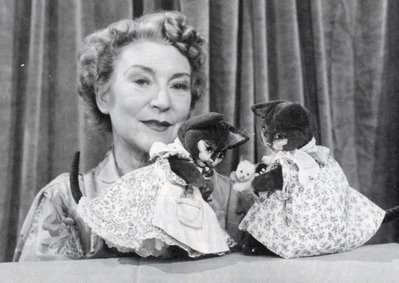 Annette Mills with Prudence and Primrose Kitten
Annette Mills with Prudence and Primrose KittenTo learn something about Molly, the obvious place to start is with her mother. Annette Mills was born Edith Mabel Mills in London, the daughter of Lewis Mills (1867-1953) and his wife Edith Catherine (
nee Baker). Lewis was a schoolmaster and the family were living in Battersea at the time of the 1901 census [where 6-year-old Edith's place of birth is given as Clapham, rather than Chelsea as per her obituary in
The Times]. In February 1908, Edith was joined by a young brother, Lewis Ernest Watts Mills, who was born at the Watts Naval School in North Elmham, Norfolk. The family subsequently moved to Suffolk when Lewis became headmaster of a school in Belton, near Great Yarmouth. Mother had once aspired to be a professional dancer and taught her children the basic steps which were to prove useful to both of them in their future careers.
Lewis jr. worked as a shipping clerk but, as a teenager, headed for London and -- as John Mills -- began appearing in revue, making his debut in the chorus of
The Five O'clock Girl at the London Hippodrome on 21 March 1929. He was spotted by Noel Coward whilst touring in the Far East which led to leading parts in the West End and thence to movies,
Scott of the Antarctic,
The Colditz Story,
Above Us the Waves,
Ice Cold in Alex,
Hobson's Choice and
Ryan's Daughter being just a few of the classics he starred in.
Edith, meanwhile, had been educated at King's Lynn High School and the Convent of Notre dame at Norwich before studying the piano and organ at the Royal Academy of Music. Although she hoped to become a concert pianist, her intentions changed when her fiance was killed in action in France.
Edith married Henry W. D. McClenaghan at Devonport in 1917 and Molly S. McClenaghan was born soon after at St. Albans. During Molly's earliest years, Edith trained as a dancing teacher and took a job teaching at a dancing academy in Notting Hill Gate.
In the early 1920s, she teamed up with a dancer named Robert Sielle who, according to the
Oxford Dictionary of National Biography, was an American, although he was actually born Cecil Leon Roberts in Liverpool in 1895. He had adopted his initials 'C. L.' as a surname to avoid confusion with another professional dancer of the same name. Roberts was a bank clerk in the Wirral before joining the infantry in 1914. However, he soon transferred to the Royal Flying Corps and his plane was subsequently shot down over enemy territory and he spent the remainder of the war as a prisoner.
Sielle returned to England in 1918 and, after being demobbed, launched himself into a new career as a professional dancer. By 1924, he and Miss Annette Mills (as she was billed) were already described as "the famous dancers" and putting on exhibition dances in London and France including a long-running cabaret at the Piccadilly Hotel. They also performed at The Little Theatre, the Alhambra, the Coliseum, sometimes billed as "the good humoured dancers" and one reviewer commented that their dancing was "greatly to the taste of the audience."
One reason for their popularity was that new sensation, the Charleston: while on tour of the southern United States, they had spent a weekend in the country and there stumbled on the dance at a local dance-hall. Sielle and Mills are credited with introducing the dance to Europe in 1925. Another tour, of South Africa, saw the couple try to introduce another new dance the 'Moochi', although
The Times wondered if it was "an authentic Zulu dance or ... an elaborate parody of modern dancing." (
The Times, 18 November 1930)
Annette Mills and Robert Sielle had married in late 1925 but the marriage had not lasted, despite their continuing partnership as dancers. They were divorced in early 1930 and split as dancers when Annette broke her leg leaping through a window on stage in Cape Town.
Cecil Leon Roberts later married Marguerite Milton (
nee Lucas) in 1945, a marriage that lasted until her death in 1978. Roberts himself died on 20 May 1983, aged 88. Turning his back on dancing, he set himself up in business in the early 1930s as a picture framer and had a very successful career working for the Tate Gallery and the National Gallery amongst others.
It was around this time that Annette Mills met the artist Gluck. Hannah Gluckstein was born in 1895 to a well off family (her father had founded the Lyons tearoom chain and her mother was a popular musician) and had attended St. John's Wood School of Art (1913-16) before leaving London for the Newlyn artist's colony in Lamorna, Cornwall. She returned to London -- although for years divided her time between London and Cornwall -- and worked in a studio at Gordon Selfridge's famous store doing instant sketches of customers. Gluckstein -- who by now insisted on being called Gluck -- had her first exhibition in 1924, followed by a number of one-artist exhibitions given by the Fine Arts Society.
Noted for always wearing male clothing, Gluck was in a relationship with Sybil Cookson, a journalist and romance novelist, who, according to
this site, "left abruptly on finding Gluck in her studio with Annette Mills." The implication that Gluck and Annette Mills had a fling is also recorded in Diane Souhami's
Gluck, 1895-1978: Her Biography (London, Pandora, 1988; rev. London, Weidenfeld & Nicolson, 2000). Gluck began another relationship, with Constance Fry, shortly after.
Mills had, in the early 1930s, turned her talents to songwriting and, according to the
Oxford Dictionary of National Biography:
Her first hit was the song and dance ‘Hands, knees, and boomps-a-daisy’, and many of her songs from the 1930s, including ‘With a Feather in her Tyrolean Hat’, were published and became popular. She appeared in cabaret and revues, and for four years wrote the words and music for C. B. Cochran's Trocadero supper shows.
Annette Mills appeared on the first In Town Tonight programme on the BBC on 18 November 1933, and went on to broadcast frequently, playing and singing her own light comedy songs and accompanying others. Her full-length radio shows included the musicals The Golden Rose (1936), Hawaiian Rhapsody (1936), and The Talking Horse (1937), and in 1936 she wrote the lyrics and the script for an all-black variety programme, Molasses Club. A talented mimic, she devised a programme, People who have Sung my Songs (1938), in which she appeared as a songwriter doing impersonations of stars such as Douglas Byng singing her songs. She appeared in the series Airs and Disgraces in 1939. She also had some contracts with Radio Luxemburg as an announcer on the Pond's Cold Cream programme, and wrote signature tunes such as ‘The Phillips' Tonic Yeast March’.
At the beginning of the Second World War, during the first air-raid warning, Annette Mills wrote the song ‘Adolf’, which became a great hit. In spring 1940 she went to Paris, where she spent three months as a cabaret artist at Lucienne Boyer's club Chez Elle: while there, she broadcast regularly to Britain, and also toured the Maginot line entertaining French troops. Although she wanted a job as a BBC announcer or producer, this did not materialize, and she spent the next two years entertaining the troops and broadcasting on the Home Service and the Forces' Programme. Her most famous wartime songs were ‘When we're home, sweet home again’ and ‘Un jour’ (1940), written at the request of the BBC French section. In November 1942, on her way back from a troop concert, she was seriously injured in a car accident, breaking both legs, and spent nearly two years in hospital, undergoing a series of operations. She came out briefly to be carried on stage for Variety Bandbox in June 1944, but spent most of her convalescence writing short stories, some of which were broadcast by the BBC, including Mum (1943), which was repeated several times and translated into Afrikaans and Spanish for overseas transmission. She also wrote plays, and Rotten Row Speaking, a hospital play, was adapted for television in 1947.
It is interesting to note that the radio play
Golden Rose (re-broadcast a number of times in the late 1930s) was based on an original story by Mills and David Blake. David H. Blake was shortly to marry her daughter, Molly S. McClenaghan in Hampstead in 1939.
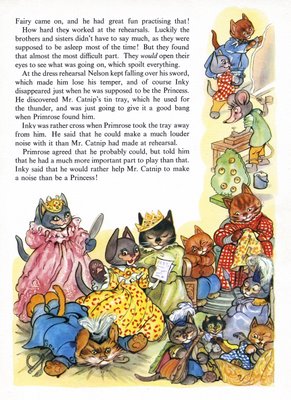
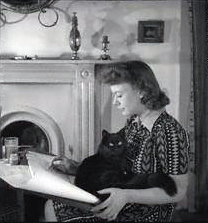
Molly Blake would go on to become a regular artist for her mother's creations as well as illustrating
Far Morning by Mary Hayley Bell, her uncle Sir John Mill's second wife. Molly and David Blake were living at 9 Gloucester Walk, W.8, in 1957, but split up shortly afterwards. For some years she lived at 8 Nassau Road, S.W.13 (ca. 1958/63) before moving to 33 Clavering Avenue, S.W.13 (ca. 1965). Before seperating, the couple had a son David and a daughter, Susan, the latter better known as Susie Blake of
Victoria Wood--As Seen on TV and
Coronation Street fame.
Now in her late eighties, Molly Blake is still alive, although I gather somewhat reclusive. There isn't a great deal known about her, as you can see... but that doesn't mean it hasn't been fascinating trying to find out what there is to be found.
Books for childrenPrudence and Primrose, illus. Kathleen Dance. London, Publicity Products, 1956.
Prudence and Celia, illus. Sheila Findlay. London, Publicity Products, 1957.
Prudence Kitten's ABC, illus. Sheila Findlay. London, Publicity Products, 1957. [pop-up book]
Illustrated BooksMuffin the Mule by Annette Mills. London, University of London Press, 1949.
More About Muffin by Annette Mills. London, University of London Press, 1950.
Muffin and the Magic Hat by Annette Mills. London, University of London Press, 1951.
Here Comes Muffin by Annette Mills. London, University of London Press, 1952.
Jennifer and the Flower Fairies by Annette Mills. London, News of the World, 1952.
Muffin at the Seaside by Annette Mills. London, University of London Press, 1953.
Muffin's Splendid Adventure by Annette Mills. London, University of London Press, 1954.
Far Morning by Mary Hayley Bell. London, Heinemann, 1962.
In Rosember by Margaret Arnold. London, Heinemann, 1962.
Rescue a Recipe, ed. Joan Hartley. London, WRVS Magazine, 1975.
NotesI've not noted every source as I was jotting down snippets from all over the place. However, some material was derived from the
Oxford Dictionary of National Biography entry on Annette Mills by Anne Pimlott Baker, obituaries of Mills, Sir John Mills and Robert Sielle in
The Times, entries on Gluck in
Gay & Lesbian Biography and the
Dictionary of Woman Artists, plus a review of Diane Souhami's biography, the Internet Movie Database and a lot of searching through birth, death and marriage records (not all of it successful). A final thanks to Adrienne Hasler who runs a fascinating
site and collectors club about Muffin the Mule and has written a book about Muffin available
here.
The photograph of Molly Blake is from the National Portrait Gallery collection and was taken by John Gay on 26 March 1947. A second photograph can be found
here.












